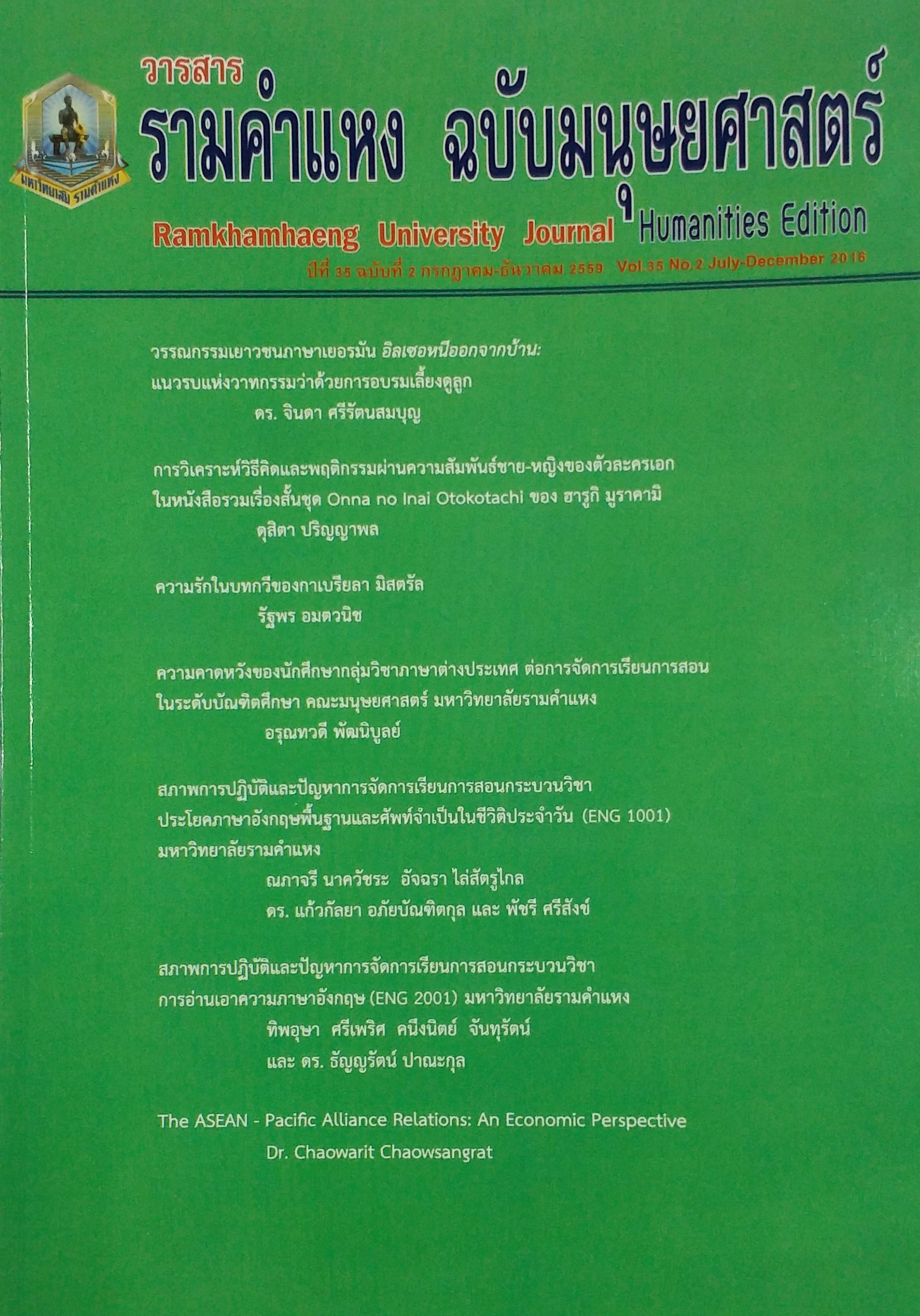The ASEAN - Pacific Alliance Relations: An Economic Perspective ความสัมพันธ์ระหว่างอาเซียนและพันธมิตรแปซิฟิก: มุมมองทางเศรษฐศาสตร์
Main Article Content
บทคัดย่อ
Abstract
The year 2016 brought much attention to the Pacific Alliance (Alianza del Pacífico), the most recent regional integration initiative in Latin America. Building on the existing free trade agreements between them, the four members of the Alliance – Chile, Colombia, Mexico and Peru – have set the goal of advancing towards the free movement of goods, services, capitals and people, with the objective of creating an “area of deep integration” to stimulate economic growth and competitiveness. Since its leaders issued the Declaration of Lima on April 28, 2011, the Pacific Alliance has come to seen as the most promising and dynamic regional group in Latin America. Adopting a free-market approach to regional integration, it is widely perceived as an alternative to the “stagnating” and “increasingly protectionist” Mercosur bloc. In this regard, the Pacific Alliance has led to hopes for a new momentum for regional integration and cooperation in Latin America, as well as to concerns about a possible fracture in the region.
The ASEAN, which has long-standing institutionalized links, liberalized trade and good relations with the members of the Pacific Alliance, has welcomed the Alliance as a promising initiative. The evolution of the Alliance could have direct or indirect consequences for the ASEAN’s relations with other regional blocs in Latin America. This article compares trade interactions between six selected ASEAN economies with the Alliance’s members. Interregional engagement between Asia and Latin America has largely taken on a bilateral approach. To deepen interregional trade, it may be best for both regions to transcend country-level engagements and consider connecting on a wider process, which is on a regional front. In this respect, the ASEAN – Pacific Alliance connection offers an option for linking both regions.
บทคัดย่อ
พ.ศ. 2559 ถือเป็นปีที่น่าจับตามองกลุ่มพันธมิตรแปซิฟิก (Pacific Alliance) ซึ่งเป็นความร่วมมือระดับภูมิภาคกลุ่มล่าสุดในลาตินอเมริกา โดยความร่วมมือครั้งนี้เกิดขึ้นจากข้อตกลงเขตการค้าเสรีที่มีมาก่อนแล้วระหว่างสมาชิกพันธมิตรทั้งสี่ประเทศ ได้แก่ โคลอมเบีย ชิลี เม็กซิโกและเปรู โดยมีเป้าหมายมุ่งเน้นการพัฒนาและส่งเสริมการแลกเปลี่ยนสินค้า การบริการ เงินทุนและทรัพยากรมนุษย์โดยเสรี และยังมีจุดประสงค์ที่มุ่งเสริมสร้างความร่วมมือระหว่างประเทศสมาชิกเพื่อกระตุ้นการแข่งขันและการเจริญเติบโตทางเศรษฐกิจ นับแต่มีการลงนามในปฏิญญาแห่งลิมาเมื่อวันที่ 28 เมษายน พ.ศ. 2554 ระหว่างผู้นำทั้งสี่ประเทศ กลุ่มพันธมิตรแปซิฟิกมีความร่วมมือกันอย่างเป็นรูปธรรมและสร้างสรรค์มากที่สุดในภูมิภาคลาตินอเมริกา และด้วยการดำเนินนโยบายการค้าแบบเสรีภายในภูมิภาค กลุ่มพันธมิตรแปซิฟิกได้รับการจับตา มองว่าเป็นอีกทางเลือกหนึ่งนอกจากกลุ่มตลาดร่วมอเมริกาใต้ตอนล่าง (Mercosur) ที่กำลังประสบปัญหาและมีนโยบายกีดกันการค้าจากนอกภูมิภาค ขณะเดียวอาเซียน (ASEAN) ก็มีความสัมพันธ์ ทางเศรษฐกิจกับกลุ่มประเทศสมาชิกพันธมิตรแปซิฟิกมาเป็นเวลานานแล้ว รวมทั้งตระหนักถึงความสำคัญของกลุ่มพันธมิตรแปซิฟิก บทความนี้ศึกษาและเปรียบเทียบความสัมพันธ์ทางการค้าระหว่างประเทศที่สำคัญหกประเทศในอาเซียน ได้แก่ อินโดนีเซีย มาเลเซีย ฟิลิปปินส์ สิงคโปร์ ไทยและเวียดนาม กับประเทศทั้งสี่ที่เป็นสมาชิกพันธมิตรแปซิฟิก นอกเหนือไปจากการวิเคราะห์ ถึงความร่วมมือระหว่างภูมิภาคเอเชียและลาตินอเมริกาซึ่งมีลักษณะความสัมพันธ์แบบทวิภาคี เป็นส่วนมาก ดังนั้น หากทั้งสองภูมิภาคมีเป้าหมายที่จะส่งเสริมการค้าระหว่างภูมิภาคมากขึ้นแล้ว ย่อมจำเป็นต้องก้าวพ้นข้อตกลงต่าง ๆ ที่อยู่เพียงระดับทวิภาคี ขยายไปสู่การดำเนินการในระดับภูมิภาค ด้วยเหตุนี้ความสัมพันธ์ระหว่างอาเซียนและพันธมิตรแปซิฟิกจึงเป็นทางเลือกหนึ่ง ที่สดใสในปัจจุบันที่จะทำหน้าที่เชื่อมทั้งสองภูมิภาคเข้าด้วยกัน
Article Details

อนุญาตภายใต้เงื่อนไข Creative Commons Attribution-NonCommercial-NoDerivatives 4.0 International License.
ประกาศลิขสิทธิ์จะปรากฏในเกี่ยวกับวารสาร ควรอธิบายสำหรับผู้อ่านและผู้เขียนว่าเจ้าของลิขสิทธิ์เป็นผู้เขียนวารสารหรือบุคคลที่สาม ควรรวมถึงข้อตกลงการอนุญาตเพิ่มเติม (เช่นใบอนุญาตครีเอทีฟคอมมอนส์) ที่ให้สิทธิ์แก่ผู้อ่าน (ดูตัวอย่าง) และควรให้วิธีการรักษาความปลอดภัยหากจำเป็นสำหรับการใช้เนื้อหาของวารสาร


